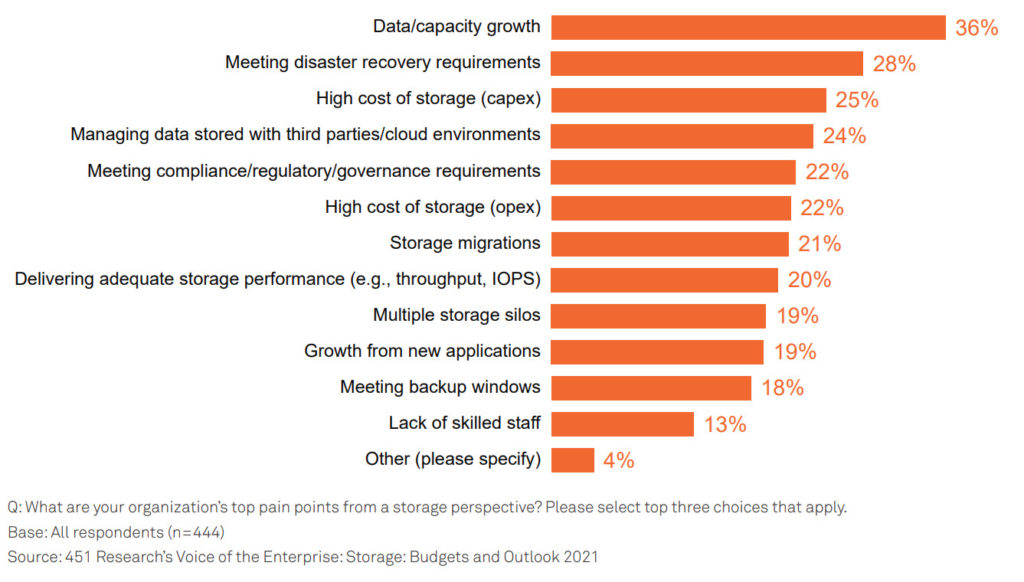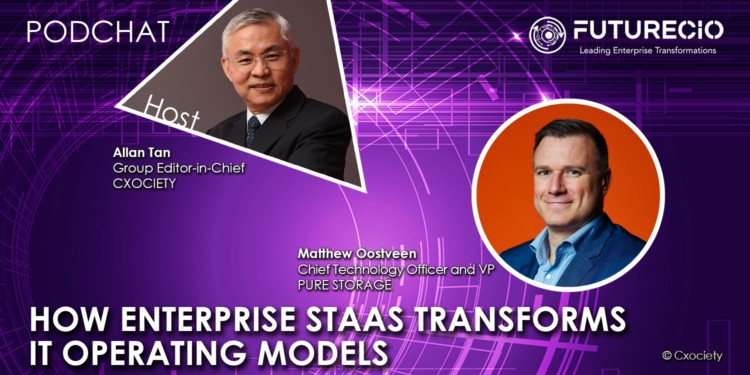Within the enterprise, Storage-as-a-service (STaaS) spans deployment environments and can be delivered both on-premises or in the cloud. It offers the ability to deliver consumption-based “pay for what you use” or OpEx capacity model along with a range of additional value-added services.
Gartner predicts that by 2025, managed, consumption-based storage systems and hybrid IT will serve as the foundation for more than 70% of corporate enterprise storage workloads. It also predicts that by 2025 59% of global corporate enterprise-grade storage petabytes (PBs) will be consumed off-premises as part of a managed STaaS hybrid IT multi-cloud initiative.
Driver of STaaS
IDC found that the technical and business benefits of STaaS offerings are driving the adoption. But more factors impacting the adoption and trend.
For Matthew Oostveen, chief technology officer and VP at Pure Storage, digital transformation is another driver. He opined that there is a lot of costs associated with digitization. They are reallocating budgets and pushing these towards innovation. This reallocation implies reducing spend in some areas.
“Storage-as-a-service allows them to replace their capital expenditure, improve allocation and improve their decision-making process as part of the process,” he added.
Indeed, the digitalization journey is creating a glut in data that must be stored somewhere. In its Voice of the Enterprise: Storage, Data Management and Disaster Recovery 2021 study, Henry Baltazar, 451 Research research director for storage and author of the report, Bridging the Hybrid IT Gap with STaaS, noted that 36% of respondents chose data/capacity growth as one of their top storage pain points.
He added that respondents said they expect their data to grow by 28% over the next 12 months, which will likely make other problems worse since organizations will have more data to protect and potentially move if they implement an off-site archiving strategy.
451 Research: Organizations are struggling with many storage challenges

Benefits of STaaS
Beyond attributes like economies of scale and simplicity, Oostveen clarified that from an accounting perspective, it is not just about the cost but how this cost is recognised by the organisation. He opined that with STaaS, you can unlock a balance sheet asset.
“You can preserve the cash for other usages,” he added. “What we know now is that organisations are rotating towards strategic initiatives, because there is a lot of uncertainty. We have got a global pandemic; we are not quite sure when things are going to lift.
“There is a lot of capital washing around within marketplaces, and there is a lot of opportunity for organisations that can cascade into new marketplaces.”
He believed that there is an opportunity cost for organisations still locked in the old paradigm of how they are acquitting their IT infrastructure and where it sits in their balance sheet.
Cloud and the need for standalone STaaS
With more organisations putting their infrastructure needs in the cloud, is there a need for on-premises STaaS? Oostveen believed that the situation in the marketplace is unique and calls for it.
“We are on the precipice of a really large change. There is a balance shift in the way that our data, and our applications, are being used, and, more importantly, where they reside.”
Acknowledging what analysts are describing as more data being created, he added that this data sits outside the data centre, outside enterprise clouds.
“And this is where we start to invoke the conversation at the edge because this is going to necessitate a need to bring the infrastructure points closer to where the data is being created. The cloud, if you think about it, is disaggregating,” he elaborated.
He acknowledged that customers want the elasticity and buying-model characteristics of the cloud. For him, on-premises storage-as-a-service brings those same benefits back to the enterprise edge.
“What matters in the new world is performance. This means proximity – being closer to the data at the point of creation. Data has grown to such a size that It’s too expensive and cumbersome to move it to other locations, where you might want to process it out of convenience,” he continued.
“It is simpler, cheaper and more efficient now, to move what you need closer to those points of creation. Standalone-STaaS is an important solution for that.”
How to buy STaaS
Oostveen said in assessing what STaas model (cloud or on-premises) to acquire, enterprises should use the same questions they would ask about implementing new technology. They need to understand their needs, perform an internal analysis.
“In the case of storage-as-a-service, it is about understanding your storage hardware administration costs of the support fees, and all of the costs that go towards keeping that environment online, above and beyond the actual acquisition costs as well,” he recommended.
He also suggested asking questions around the application ecosystem – in much the same way when reviewing a cloud strategy.
“You need to understand what pressure the application ecosystem places upon the infrastructure. What SLAs must be met? How do you ensure that the users that are connected to these applications are getting the experience that's necessary for them to be able to complete their work?”
He acknowledged that there are many solutions in the market and warned that not all STaaS is created equal. Verify if it is a true utility model or a lease in disguise!
He went back to an earlier recommendation on reviewing an enterprise’s financial engineering associated with how the company treats its technology on its books.
“If you don't have the accounting standards in place, you are still going to have assets sitting on a balance sheet. You are not going to be able to hit the key objectives that an organisation has,” he warned.
He concluded that enterprises must understand what they need and communicate this clearly to the vendor.
Click on the podchat player to listen to Oostveen offer his view on how enterprise STaaS transforms IT operating models.
- Name one top driver of STaaS in Asia.
- Name one quality that you think enterprise customers want from STaaS solutions.
- Name one top benefit of STaaS in Asia.
- Given the shift to a public cloud, do enterprises still need (standalone) STaaS solutions?
- How would an enterprise determine whether they need STaaS? How to select the right solution for them?
- How do you envision enterprise storage as a service transforming IT operating models? What skills will stand out in this new IT operating model?





